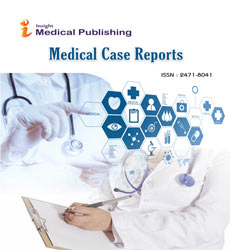The Challenges and Importance of Early Detection in Sinonasal Intestinal-Type Adenocarcinoma
Yamini Kumara
Department of Oral Pathology, Rajiv Gandhi University of Health Sciences, Bangalore, Karnataka, India, Email: ykumari@gmail.com
Published Date: 2024-11-28DOI10.36648/2471-8041.10.6.409
Yamini Kumara*
1Department of Oral Pathology, Rajiv Gandhi University of Health Sciences, Bangalore, Karnataka, India
- *Corresponding Author:
- Yamini Kumara
Department of Oral Pathology, Rajiv Gandhi University of Health Sciences, Bangalore, Karnataka, India
E-mail: ykumari@gmail.com
Received date: October 29, 2024, Manuscript No. IPMCRS-24-20064; Editor assigned date: October 31, 2024, PreQC No. IPMCRS-24-20064 (PQ); Reviewed date: November 14, 2024, QC No. IPMCRS-24-20064; Revised date: November 21, 2024, Manuscript No. IPMCRS-24-20064 (R); Published date: November 28, 2024, DOI: 10.36648/2471-8041.10.6.409
Citation: Kumara Y ( 2024) The Challenges and Importance of Early Detection in Sinonasal Intestinal-Type Adenocarcinoma. Med Cas e Rep Vol.10 No.6: 409.
Description
Sinonasal cancers are among the rarest and most difficult malignancies to identify and manage. Intestinal-Type Sinonasal Adenocarcinoma (ITAC) is a distinctive form of cancer that exhibits aggressive clinical characteristics, frequently diagnosed at a late stage. While the majority of sinonasal tumors are linked to environmental or occupational risks like wood dust some instances emerge in individuals without those risk factors. A notable example is a case involving a 53-year-old male book vendor with no identified occupational exposure. This case emphasizes the essential need for increased awareness, early identification and a collaborative treatment approach for these complex cancers.
Rarity and diagnosis challenges
ITAC is a subtype of adenocarcinoma that resembles intestinal cancer. It represents a small fraction of sinonasal malignancies, with an occurrence of 8%-25% of all sinonasal tumors. Its infrequency, along with the vague early symptoms such as nasal obstruction and facial swelling often results in delayed diagnosis. By the time ITAC is identified, it generally arises at an advanced stage, affecting not only the sinuses but also the adjacent bones and structures. The discussed case, which involved tumor spread to the maxillary and ethmoid sinuses and the mandibular condyle, illustrates how ITAC can imitate common ailments and appear in atypical manners.
For medical professionals, identifying ITAC necessitates not only a strong clinical suspicion but also a comprehensive grasp of the tumor’s pathology and its capacity to resemble other conditions. In the highlighted case, imaging examinations indicated significant destruction of bone structures, a finding typically associated with more advanced or metastatic conditions. The patient’s difficulty in opening his mouth was not initially linked to cancer but rather attributed to more typical TMJ disorders. This underscores the necessity for healthcare providers to contemplate rare diseases, especially when standard treatments for more common ailments do not resolve the problem.
The role of occupational risk factors and nonoccupational cases
ITACs are commonly associated with wood dust exposure in specific jobs, particularly in sectors such as furniture, leather and textile manufacturing. Wood dust is considered a human carcinogen by the International Agency for Research on Cancer (IARC) and workers in these fields have been shown to have a significantly elevated risk of developing ITAC. However, this case is unique due to the patient’s lack of any such occupational exposure.
While the patient in this case was employed as a book vendora role not generally linked to the high levels of wood dust exposure characteristic of the furniture industry this does not eliminate the possibility of environmental or other forms of exposure that could be associated with cancer development. The fact that ITAC can manifest sporadically in individuals without occupational risk factors further complicates the diagnosis and prevention of this disease. Such instances emphasize the need for a more thorough understanding of the environmental and genetic factors involved in the development of ITAC.
Importance of early diagnosis and timely intervention
A significant takeaway from this case is the necessity of early detection. The patient initially postponed seeking medical help due to the relatively mild nature of his symptoms and potential socioeconomic limitations. If patient had pursued treatment sooner, it is conceivable that intervention at an earlier stage could have enhanced his prognosis and minimized the need for invasive procedures. Early diagnosis can possibly lead to less extensive surgeries, reduced damage to surrounding tissues and an overall improved outcome.
Moreover, this case underscores the importance for clinicians to consider a wide differential diagnosis, particularly when symptoms overlap with more common ailments. In this scenario, the unusual involvement of the mandibular condyle raised concerns about possible metastasis, ultimately guiding the diagnosis of ITAC. A multidisciplinary approach, incorporating insights from specialists in radiology, pathology and surgery, is essential for ensuring an accurate diagnosis and appropriate treatment plan. The use of advanced diagnostic techniques such as histopathology, immunohistochemistry and molecular testing can assist clinicians in determining the tumor’s origin and differentiating ITAC from other malignancies, especially those arising from the colon or rectum.
The need for public awareness and preventive measures
Beyond clinical considerations, there is an urgent need for public awareness about rare malignancies like ITAC. The case highlighted was from a patient who possessed limited knowledge of the condition, which likely contributed to the delay in seeking treatment. Awareness campaigns, especially targeting individuals in high-risk occupations and those exposed to environmental carcinogens, can significantly aid in early detection.
Furthermore, providing patients with information on warning signs and promoting regular check-ups, particularly for those at risk, can greatly improve outcomes.
Conclusion
ITAC is an uncommon yet aggressive cancer that poses distinct difficulties for diagnosis and treatment. The case presented in this article highlights the importance of not dismissing rare cancers, even when known risk factors are lacking. By improving early detection, increasing public awareness and establishing thorough treatment plans, we can enhance outcomes for those impacted by this rare and frequently severe illness. Ultimately, deepening our knowledge of these cancers and refining diagnostic and treatment methods will save lives and lessen the impact of sinonasal adenocarcinomas on patients and the healthcare system.

Open Access Journals
- Aquaculture & Veterinary Science
- Chemistry & Chemical Sciences
- Clinical Sciences
- Engineering
- General Science
- Genetics & Molecular Biology
- Health Care & Nursing
- Immunology & Microbiology
- Materials Science
- Mathematics & Physics
- Medical Sciences
- Neurology & Psychiatry
- Oncology & Cancer Science
- Pharmaceutical Sciences
